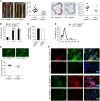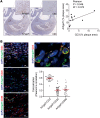Leukocyte RhoA exchange factor Arhgef1 mediates vascular inflammation and atherosclerosis
- PMID: 29130930
- PMCID: PMC5707138
- DOI: 10.1172/JCI92702
Leukocyte RhoA exchange factor Arhgef1 mediates vascular inflammation and atherosclerosis
Abstract
Abnormal activity of the renin-angiotensin-aldosterone system plays a causal role in the development of hypertension, atherosclerosis, and associated cardiovascular events such as myocardial infarction, stroke, and heart failure. As both a vasoconstrictor and a proinflammatory mediator, angiotensin II (Ang II) is considered a potential link between hypertension and atherosclerosis. However, a role for Ang II-induced inflammation in atherosclerosis has not been clearly established, and the molecular mechanisms and intracellular signaling pathways involved are not known. Here, we demonstrated that the RhoA GEF Arhgef1 is essential for Ang II-induced inflammation. Specifically, we showed that deletion of Arhgef1 in a murine model prevents Ang II-induced integrin activation in leukocytes, thereby preventing Ang II-induced recruitment of leukocytes to the endothelium. Mice lacking both LDL receptor (LDLR) and Arhgef1 were protected from high-fat diet-induced atherosclerosis. Moreover, reconstitution of Ldlr-/- mice with Arhgef1-deficient BM prevented high-fat diet-induced atherosclerosis, while reconstitution of Ldlr-/- Arhgef1-/- with WT BM exacerbated atherosclerotic lesion formation, supporting Arhgef1 activation in leukocytes as causal in the development of atherosclerosis. Thus, our data highlight the importance of Arhgef1 in cardiovascular disease and suggest targeting Arhgef1 as a potential therapeutic strategy against atherosclerosis.
Keywords: Atherosclerosis; G-proteins; Integrins; Vascular Biology.
Conflict of interest statement
Figures






Similar articles
-
Angiotensin II activates the RhoA exchange factor Arhgef1 in humans.Hypertension. 2015 Jun;65(6):1273-8. doi: 10.1161/HYPERTENSIONAHA.114.05065. Epub 2015 Apr 13. Hypertension. 2015. PMID: 25870189
-
CalDAG-GEFI Deficiency Reduces Atherosclerotic Lesion Development in Mice.Arterioscler Thromb Vasc Biol. 2016 May;36(5):792-9. doi: 10.1161/ATVBAHA.115.306347. Epub 2016 Mar 17. Arterioscler Thromb Vasc Biol. 2016. PMID: 26988592 Free PMC article.
-
The Rho exchange factor Arhgef1 mediates the effects of angiotensin II on vascular tone and blood pressure.Nat Med. 2010 Feb;16(2):183-90. doi: 10.1038/nm.2079. Epub 2010 Jan 24. Nat Med. 2010. PMID: 20098430
-
Angiotensin II and leukocyte trafficking: New insights for an old vascular mediator. Role of redox-signaling pathways.Free Radic Biol Med. 2020 Sep;157:38-54. doi: 10.1016/j.freeradbiomed.2020.02.002. Epub 2020 Feb 11. Free Radic Biol Med. 2020. PMID: 32057992 Review.
-
Angiotensin, LDL peroxidation and atherosclerosis.Life Sci. 1998;63(1):1-11. doi: 10.1016/s0024-3205(98)00014-9. Life Sci. 1998. PMID: 9667759 Review.
Cited by
-
MicroRNA-1253 Regulation of WASF2 (WAVE2) and its Relevance to Racial Health Disparities.Genes (Basel). 2020 May 20;11(5):572. doi: 10.3390/genes11050572. Genes (Basel). 2020. PMID: 32443852 Free PMC article.
-
Dual spatially resolved transcriptomics for human host-pathogen colocalization studies in FFPE tissue sections.Genome Biol. 2023 Oct 19;24(1):237. doi: 10.1186/s13059-023-03080-y. Genome Biol. 2023. PMID: 37858234 Free PMC article.
-
Arhgef1 Plays a Vital Role in Platelet Function and Thrombogenesis.J Am Heart Assoc. 2019 May 7;8(9):e011712. doi: 10.1161/JAHA.118.011712. J Am Heart Assoc. 2019. PMID: 30994039 Free PMC article.
-
Loss of ARHGEF1 causes a human primary antibody deficiency.J Clin Invest. 2019 Mar 1;129(3):1047-1060. doi: 10.1172/JCI120572. Epub 2019 Feb 4. J Clin Invest. 2019. PMID: 30521495 Free PMC article.
-
Role of Macrophages and RhoA Pathway in Atherosclerosis.Int J Mol Sci. 2020 Dec 28;22(1):216. doi: 10.3390/ijms22010216. Int J Mol Sci. 2020. PMID: 33379334 Free PMC article. Review.
References
-
- de Gasparo M, Catt KJ, Inagami T, Wright JW, Unger T. International union of pharmacology. XXIII. The angiotensin II receptors. Pharmacol Rev. 2000;52(3):415–472. - PubMed
-
- Cassis LA, Rateri DL, Lu H, Daugherty A. Bone marrow transplantation reveals that recipient AT1a receptors are required to initiate angiotensin II-induced atherosclerosis and aneurysms. Arterioscler Thromb Vasc Biol. 2007;27(2):380–386. - PubMed
Publication types
MeSH terms
Substances
LinkOut - more resources
Full Text Sources
Other Literature Sources
Medical
Molecular Biology Databases
Research Materials
Miscellaneous

